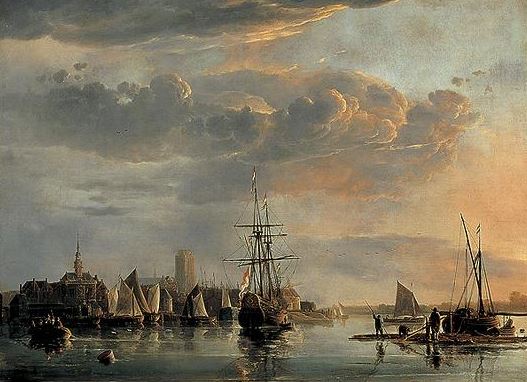Aelbert Cuyp (1620–1691) stands out as a significant figure in the Dutch Golden Age of painting. Hailing from Dordrecht, Netherlands, Cuyp is celebrated for his captivating landscapes and serene pastoral scenes. His work is notable for its masterful use of light and atmosphere, capturing the beauty and tranquility of rural life. Cuyp’s paintings not only reflect the natural splendor of the Dutch countryside but also convey a sense of timelessness and calm that has secured his place as one of the era’s most distinguished landscape artists.
1. Early Life and Background
Aelbert Cuyp was born in Dordrecht, a city renowned for its artistic heritage, in 1620. His early years were deeply influenced by his surroundings and family. Cuyp’s father, Jacob Cuyp, was a successful painter in his own right, specializing in portraits and still lifes. Aelbert likely received his initial artistic training from his father, gaining a foundational understanding of painting techniques and style. Growing up in an environment rich with artistic activity, Cuyp was well-positioned to develop his own distinctive approach to art.

2. Artistic Style and Influence
Cuyp’s artistic style is distinguished by its luminous quality and atmospheric effects. His landscapes often feature wide, open skies and expansive views that are bathed in warm, golden light. This use of light not only highlights the natural beauty of the scene but also creates a serene and contemplative mood. Cuyp’s paintings are characterized by their attention to detail and the subtle interplay of light and shadow, which brings his rural settings to life.
Common themes in Cuyp’s work include pastoral scenes, cattle, and various aspects of agrarian life. His depictions of cattle are particularly notable for their realism and the way they harmonize with the surrounding landscape. Cuyp’s landscapes often include tranquil rivers, rolling hills, and quiet rural settings, all of which contribute to the peaceful atmosphere of his paintings.
Cuyp’s innovative approach to capturing light and atmosphere had a profound influence on his contemporaries and later artists. His work inspired English landscape painters of the 18th century and left a lasting mark on the evolution of landscape painting. Cuyp’s ability to convey the essence of the Dutch countryside through his art continues to be celebrated, and his paintings remain highly regarded for their beauty and technical mastery.

3. Notable Works
“The Maas at Dordrecht”
“The Maas at Dordrecht” is one of Aelbert Cuyp’s most celebrated paintings. This expansive work offers a panoramic view of the river Maas, with the city of Dordrecht in the background. The painting is renowned for its masterful depiction of light reflecting off the water and the expansive, atmospheric sky that dominates the composition. Cuyp’s use of light and shadow, along with the tranquil portrayal of the river and its surroundings, exemplifies his skill in capturing the serene beauty of the Dutch landscape. The painting is significant not only for its artistic quality but also for its historical value, representing the natural and architectural features of Dordrecht in the 17th century.
“River Landscape with Cattle”
In “River Landscape with Cattle,” Cuyp showcases his ability to blend pastoral elements with a serene natural setting. This work features a peaceful river scene with cattle grazing by the water’s edge, set against a backdrop of rolling hills and a dramatic sky. The painting highlights Cuyp’s attention to detail in the rendering of animals and the reflective quality of the water. The composition’s balance and the warm, golden light enhance the tranquil atmosphere of the scene, reflecting Cuyp’s deep appreciation for rural life and nature.
“A Herdsman with Cattle in a River Landscape”
“A Herdsman with Cattle in a River Landscape” is another exemplary piece by Cuyp that combines pastoral elements with a striking natural landscape. The painting depicts a herdsman guiding his cattle along a riverbank, with the landscape stretching out in the distance. Cuyp’s use of light and color in this work creates a harmonious and peaceful scene, emphasizing the connection between the herdsman, his cattle, and the natural environment. This work is significant for its detailed depiction of rural life and its reflection of Cuyp’s skill in capturing the essence of the Dutch countryside.
4. Legacy and Impact
Aelbert Cuyp’s influence extends beyond his lifetime, impacting later artists and contributing to the evolution of landscape painting. His innovative approach to light and atmosphere inspired English landscape painters of the 18th century, who admired and emulated his techniques. Cuyp’s ability to convey the beauty and tranquility of rural life left a lasting impression on the art world, securing his place as a key figure in art history.
His work continues to be celebrated and studied, with many of his paintings housed in major museums and galleries around the world. Institutions such as the Rijksmuseum in Amsterdam, the National Gallery in London, and the Metropolitan Museum of Art in New York feature his works, ensuring that his artistic contributions remain accessible to contemporary audiences. Cuyp’s enduring legacy is a testament to his exceptional talent and his significant role in the Dutch Golden Age of painting.
5. Conclusion
Aelbert Cuyp made substantial contributions to the art world through his masterful landscape paintings and pastoral scenes. His ability to capture the serene beauty of the Dutch countryside and his innovative use of light and atmosphere have left a lasting impact on art history. Cuyp’s work not only reflects the natural splendor of his time but also continues to resonate with audiences today. His paintings remain a testament to his skill and vision, securing his place as one of the most celebrated landscape artists of the Dutch Golden Age.
FAQ
1. Who was Aelbert Cuyp?
Aelbert Cuyp was a Dutch painter from the 17th century, renowned for his landscape paintings. Born in Dordrecht, Netherlands, in 1620, Cuyp is celebrated for his depictions of the Dutch countryside, characterized by warm, golden light and serene pastoral scenes. His work is a significant part of the Dutch Golden Age of painting.
2. What are Aelbert Cuyp’s most famous paintings?
Some of Cuyp’s most notable works include:
- “The Maas at Dordrecht”: A panoramic view of the river Maas showcasing Cuyp’s skill in capturing light and atmosphere.
- “River Landscape with Cattle”: A tranquil river scene featuring cattle, reflecting Cuyp’s attention to detail and natural beauty.
- “A Herdsman with Cattle in a River Landscape”: This painting depicts a herdsman and his cattle by a river, illustrating Cuyp’s ability to blend pastoral elements with serene landscapes.
3. What characterized Aelbert Cuyp’s painting style?
Cuyp’s painting style is distinguished by its use of warm, golden light and atmospheric effects. His landscapes often feature wide, open skies and tranquil rural scenes, with a focus on natural lighting and the interplay of light and shadow. Cuyp’s works are known for their serenity and detailed depiction of rural life, including cattle and pastoral settings.
4. How did Aelbert Cuyp influence later artists?
Aelbert Cuyp’s innovative approach to light and atmosphere had a significant influence on later artists, particularly English landscape painters of the 18th century. His technique of capturing the effects of light and his portrayal of peaceful rural scenes inspired other artists and contributed to the development of landscape painting.
5. Where can I see Aelbert Cuyp’s paintings?
Cuyp’s works are housed in several major museums and galleries, including:
- The Rijksmuseum in Amsterdam: Aelbert Cuyp – Artworks and Biography
- The National Gallery in London: Aelbert Cuyp – Paintings
- The Metropolitan Museum of Art in New York: Aelbert Cuyp – Collection
- The Tate Gallery in London: Aelbert Cuyp – Overview
6. What is the significance of Cuyp’s work in art history?
Aelbert Cuyp’s work is significant for its contribution to the Dutch Golden Age of painting, particularly in the genre of landscape art. His ability to capture the natural beauty of the Dutch countryside with a unique use of light and color has left a lasting legacy in art history. Cuyp’s paintings are celebrated for their aesthetic beauty and technical skill, and they continue to be highly regarded by collectors and art enthusiasts.



